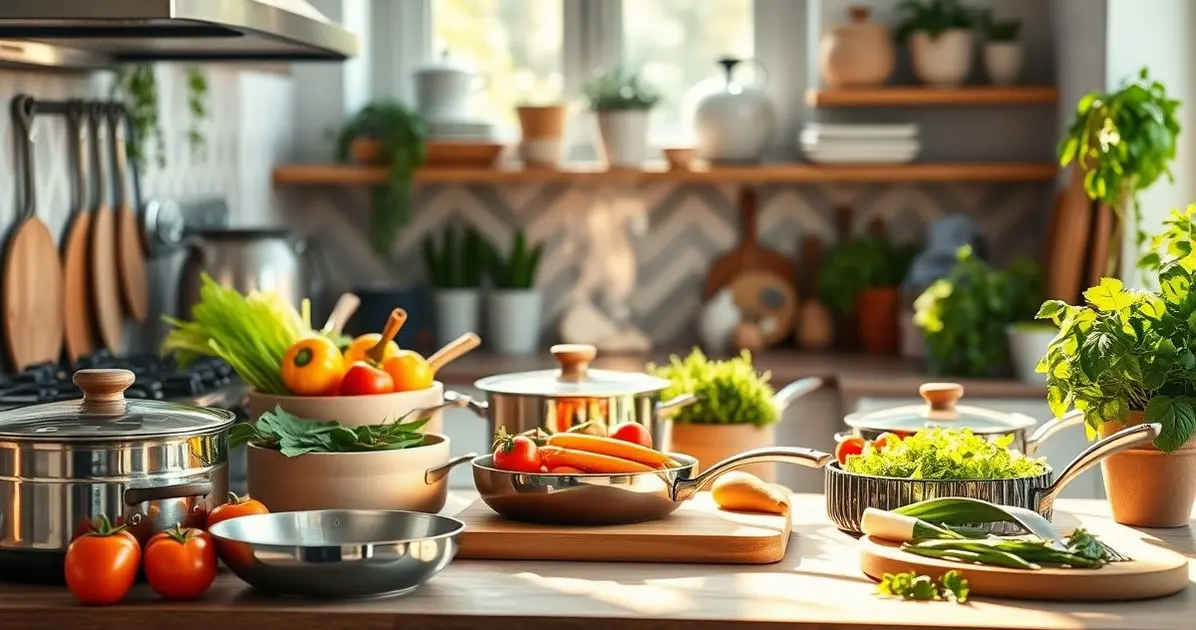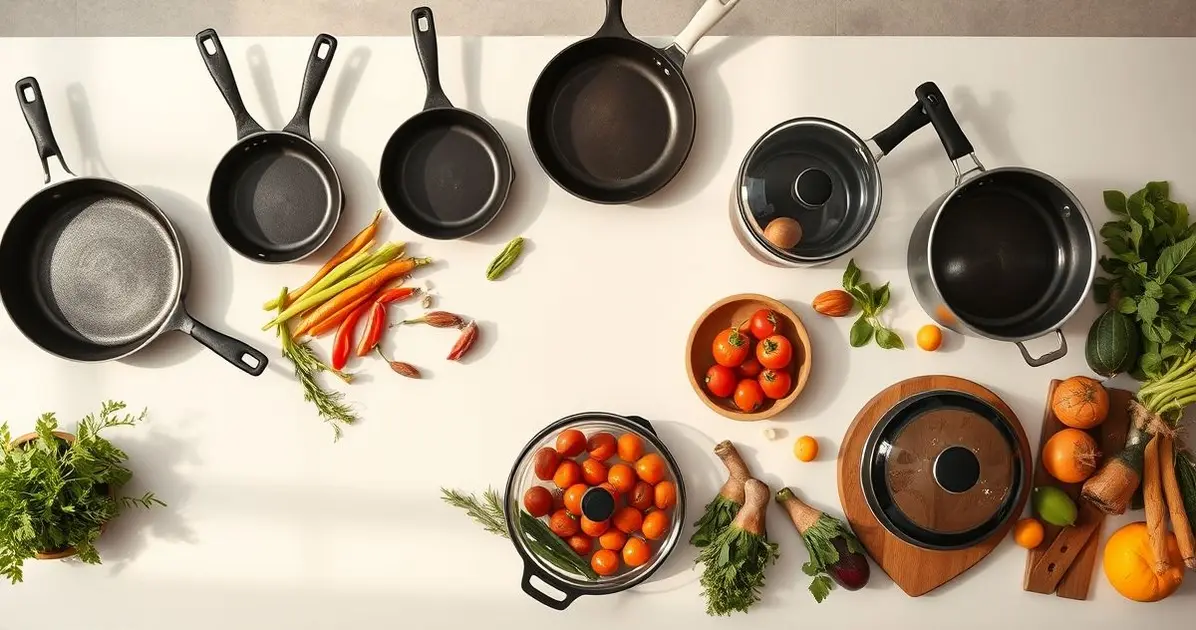When it comes to healthy cooking, choosing non-toxic cookware is essential. Non-toxic pans ensure your meals are safe from harmful chemicals, promoting a healthier lifestyle.
What cooking pans are non toxic

Non-toxic cooking pans include materials like ceramic, stainless steel, cast iron, and glass. These options avoid harmful chemicals often found in conventional cookware, making them safer for both you and the environment.
Materials for Non-Toxic Cookware
When it comes to choosing non-toxic cookware, the materials used play a crucial role in ensuring safety and health in the kitchen. Here’s a look at some of the best materials for non-toxic cookware, along with their benefits:
1. Stainless Steel: Stainless steel is one of the safest materials for cookware. Key benefits include:
- Durability: Stainless steel is highly durable and resistant to rust, corrosion, and scratching, making it a long-lasting option.
- Non-Reactive: It does not react with acidic or alkaline foods, ensuring that flavors remain pure and intact.
- Easy to Clean: Stainless steel cookware is dishwasher safe and easy to sanitize, promoting a hygienic cooking environment.
2. Cast Iron: Cast iron cookware is another excellent choice for non-toxic cooking:
- Natural Non-Stick Surface: When properly seasoned, cast iron develops a natural non-stick surface that enhances flavor and texture.
- Heat Retention: Cast iron is known for its exceptional heat retention, providing even cooking and excellent browning.
- Iron Fortification: Cooking with cast iron can add trace amounts of iron to your food, which is beneficial for those with iron deficiencies.
3. Ceramic Cookware: Ceramic cookware is a safe alternative that is free from harmful chemicals:
- Non-Toxic Coating: Ceramic is made from natural materials and does not release harmful fumes when heated.
- Non-Stick Properties: Many ceramic pans are non-stick, making them easy to cook with and clean.
4. Glass Cookware: Glass is another safe option for cooking:
- Non-Reactive: Glass does not leach chemicals into food and is safe for cooking and storage.
- Versatility: Glass cookware can be used in the oven, microwave, and refrigerator, making it a versatile choice for various cooking methods.
5. Silicone Cookware: Food-grade silicone is a popular choice for non-toxic baking and cooking:
- Heat Resistance: Silicone can withstand high temperatures without melting or warping, making it suitable for various cooking applications.
- Non-Stick Properties: Silicone is naturally non-stick, which simplifies the cooking and cleaning process.
In summary, selecting non-toxic cookware made from materials like stainless steel, cast iron, ceramic, glass, and silicone is essential for promoting health and safety in the kitchen. By understanding the benefits of these materials, you can make informed choices that enhance your cooking experience while prioritizing your well-being.
Benefits of Stainless Steel and Cast Iron Pans
Stainless steel and cast iron pans are two of the most popular choices for cookware, each offering a unique set of benefits that make them ideal for various cooking tasks. Here’s a closer look at the advantages of both stainless steel and cast iron pans:
Benefits of Stainless Steel Pans:
- Durability: Stainless steel pans are highly durable and resistant to rust, corrosion, and scratching. They can withstand high temperatures and are less likely to warp over time, making them a long-lasting investment for your kitchen.
- Non-Reactive Surface: Stainless steel does not react with acidic or alkaline foods, ensuring that the flavors of your dishes remain pure. This quality makes stainless steel ideal for cooking a wide range of foods, from sauces to meats.
- Easy to Clean: Stainless steel pans are dishwasher safe and easy to clean by hand. They can be scrubbed without fear of damaging the surface, which is beneficial for removing stuck-on food residues.
- Even Heat Distribution: High-quality stainless steel pans often feature a core of aluminum or copper, which enhances heat distribution and prevents hot spots, leading to more consistent cooking results.
Benefits of Cast Iron Pans:
- Natural Non-Stick Surface: When properly seasoned, cast iron pans develop a natural non-stick surface that improves with use. This seasoning process not only enhances the flavor of dishes but also makes cooking and cleaning easier.
- Excellent Heat Retention: Cast iron pans are known for their ability to retain heat exceptionally well. This property allows for even cooking and browning, making them ideal for frying, baking, and slow-cooking.
- Versatility: Cast iron cookware can be used on the stovetop, in the oven, or even over an open flame, making them incredibly versatile for various cooking methods.
- Iron Fortification: Cooking with cast iron can add trace amounts of iron to your food, which can be beneficial for those with iron deficiencies or anemia.
In summary, both stainless steel and cast iron pans offer unique benefits that cater to different cooking needs. Stainless steel pans provide durability, non-reactivity, and easy maintenance, while cast iron pans offer natural non-stick properties, excellent heat retention, and versatility. Incorporating both types of cookware into your kitchen can enhance your culinary experience and allow you to tackle a wide range of cooking tasks with confidence.

Exploring Ceramic and Glass Cookware
Exploring ceramic and glass cookware reveals two popular options that are both safe and versatile for various cooking tasks. Each material has its unique properties and advantages, making them excellent choices for health-conscious consumers. Here’s a closer look at ceramic and glass cookware:
1. Ceramic Cookware: Ceramic cookware is made from natural clay that is fired at high temperatures, resulting in a durable and non-toxic cooking surface. Key benefits include:
- Non-Toxic Coating: Ceramic cookware is free from harmful chemicals such as PFOA and PTFE, making it a safe choice for cooking. It does not release toxic fumes when heated, ensuring a healthier cooking environment.
- Non-Stick Properties: Many ceramic pans feature a non-stick surface that allows for easy cooking and cleanup. Food releases easily from ceramic cookware, reducing the need for excessive oils or fats.
- Even Heat Distribution: Ceramic cookware provides even heat distribution, which helps to prevent hot spots and ensures that food cooks uniformly. This is particularly beneficial for baking and roasting.
- Versatility: Ceramic cookware is suitable for a variety of cooking methods, including baking, roasting, and stovetop cooking. Many ceramic dishes are also oven-safe and microwave-safe, adding to their versatility.
2. Glass Cookware: Glass cookware is another excellent option that offers safety and functionality in the kitchen. Key benefits include:
- Non-Reactive Material: Glass is non-reactive, meaning it does not leach chemicals into food or react with acidic ingredients. This makes it a safe choice for cooking and storing food.
- Easy Monitoring: The transparency of glass cookware allows you to monitor the cooking process without lifting the lid, making it easier to check for doneness.
- Versatility: Glass cookware can be used in the oven, microwave, and refrigerator, providing flexibility for various cooking and storage needs. It’s also suitable for baking, casseroles, and even serving dishes.
- Health Benefits: Glass cookware is often dishwasher safe and easy to clean, reducing the risk of bacterial growth and ensuring a hygienic cooking environment.
In summary, both ceramic and glass cookware offer safe, non-toxic options for cooking that can enhance your culinary experience. Their unique properties, such as non-stick surfaces, even heat distribution, and versatility, make them excellent choices for health-conscious consumers. By incorporating ceramic and glass cookware into your kitchen, you can enjoy the benefits of safe cooking while creating delicious meals.
Eco-Friendly Brands Committed to Safety
Choosing eco-friendly brands committed to safety is essential for health-conscious consumers looking to purchase non-toxic cooking utensils. These brands prioritize sustainable practices, high-quality materials, and safety standards to ensure that their products are safe for both consumers and the environment. Here are some notable eco-friendly brands that exemplify this commitment:
1. GreenPan: GreenPan is known for its ceramic non-stick cookware that is free from harmful chemicals such as PFOA and PFAS. Their products are made from eco-friendly materials and are designed to be safe and durable:
- Commitment to Safety: GreenPan uses a proprietary Thermolon coating that is free from toxic substances, ensuring a safe cooking experience.
- Sustainable Practices: The brand focuses on sustainable manufacturing processes, minimizing waste and environmental impact.
2. Lodge: Lodge is a well-known brand that specializes in cast iron cookware. Their commitment to safety and sustainability includes:
- Durability: Lodge cast iron pans are built to last a lifetime, reducing the need for frequent replacements and minimizing waste.
- Natural Materials: Their products are made from natural materials and are free from synthetic coatings, making them a safe choice for cooking.
3. T-fal: T-fal offers a range of non-toxic cookware options, including their ceramic-coated non-stick pans. Key features include:
- BPA-Free Products: T-fal ensures that their cookware is free from BPA and other harmful chemicals, prioritizing consumer safety.
- Environmental Responsibility: The brand is committed to reducing its environmental footprint through responsible sourcing and manufacturing practices.
4. OXO: OXO is known for its kitchen tools and gadgets that combine functionality with safety. Their commitment includes:
- High-Quality Materials: OXO products are made from safe, durable materials that are free from harmful chemicals, ensuring safe food preparation.
- User-Friendly Design: The brand focuses on ergonomic designs that enhance usability while maintaining safety standards.
5. Bamboozle: Bamboozle specializes in eco-friendly kitchenware made from sustainable bamboo and other natural materials. Their commitment to safety includes:
- Non-Toxic Products: Bamboozle products are free from harmful chemicals and are biodegradable, making them an environmentally friendly choice.
- Eco-Conscious Practices: The brand emphasizes sustainable sourcing and manufacturing processes, contributing to a healthier planet.
In summary, choosing eco-friendly brands committed to safety ensures that your cooking utensils are non-toxic and made from sustainable materials. Brands like GreenPan, Lodge, T-fal, OXO, and Bamboozle exemplify this commitment, providing safe and high-quality products for health-conscious consumers. By supporting these brands, you can make informed choices that benefit both your health and the environment.
Conclusion
In conclusion, selecting eco-friendly brands committed to safety is essential for health-conscious consumers seeking non-toxic cooking utensils. Brands like GreenPan, Lodge, T-fal, OXO, and Bamboozle prioritize sustainable practices and high-quality materials, ensuring that their products are safe for both users and the environment.
By choosing cookware and utensils that are free from harmful chemicals and made from sustainable resources, you not only promote your health but also contribute to environmental conservation. Understanding the importance of these choices empowers you to create a safer and more environmentally friendly kitchen.
Ultimately, supporting brands that align with your values can enhance your culinary experience while fostering a commitment to health and sustainability. By making informed decisions about the cooking tools you use, you can enjoy cooking with peace of mind, knowing that you are contributing to a healthier lifestyle and a cleaner planet.
FAQ – Frequently Asked Questions about Eco-Friendly Cooking Utensils
What are eco-friendly cooking utensils?
Eco-friendly cooking utensils are made from sustainable materials that are non-toxic and safe for food preparation, such as stainless steel, bamboo, and silicone.
Why is it important to choose non-toxic cooking utensils?
Choosing non-toxic cooking utensils minimizes exposure to harmful chemicals, promoting better health and safety in the kitchen.
What are the benefits of using stainless steel and cast iron cookware?
Stainless steel is durable and non-reactive, while cast iron offers excellent heat retention and a natural non-stick surface when seasoned properly.
How can I identify safe brands for cooking utensils?
Look for certifications like BPA-free labels, research brand reputations, and choose products made from food-safe materials.
What materials should I avoid in cooking utensils?
Avoid utensils made from harmful materials like plastics containing BPA, Teflon-coated pans that may release toxic fumes, and any products with questionable safety certifications.
Are there any sustainable brands I should consider?
Yes, brands like GreenPan, Lodge, T-fal, OXO, and Bamboozle are known for their commitment to safety and sustainability in their cooking products.
See more
Discover plenty of easy and delicious recipes you can make at home, from hearty dinners to indulgent desserts and wholesome breakfasts.




